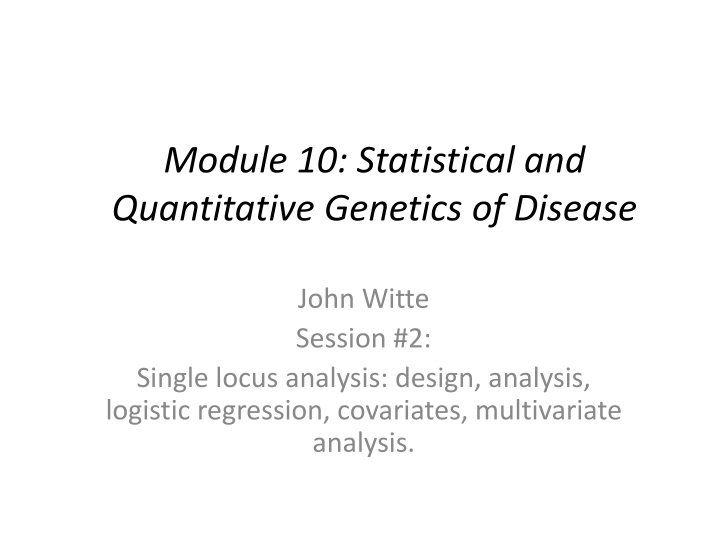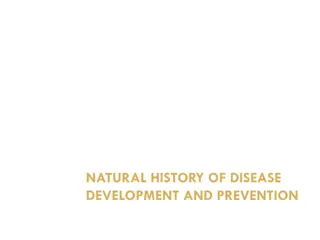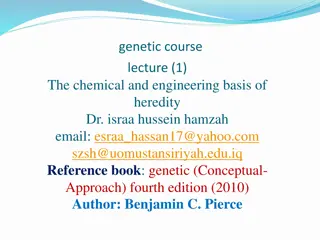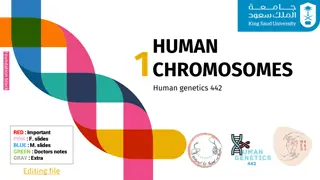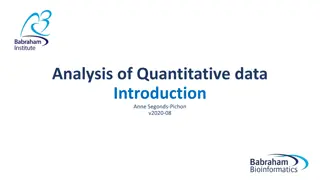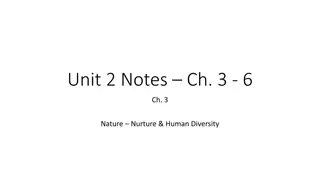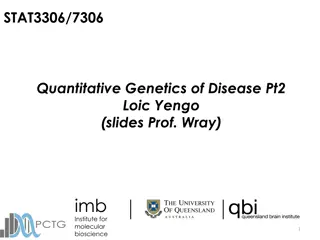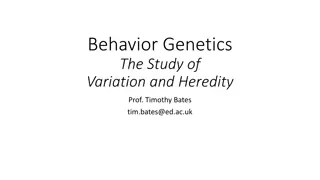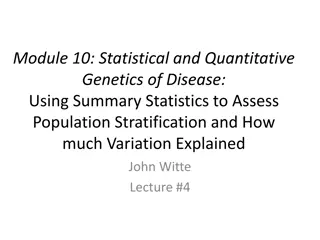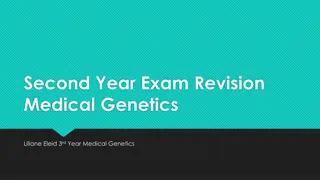Statistical and Quantitative Genetics of Disease
This session covers single locus analysis in statistical and quantitative genetics, focusing on design, analysis, logistic regression, covariates, and multivariate analysis. It discusses approaches for analyzing DNA on cases and controls, modeling, and adjusting for covariates. The association analysis includes genotype frequencies, chi-square tests, and testing for associations using observed and expected values. It also delves into genetic models and provides an example of Harry Potter's pedigree.
Download Presentation

Please find below an Image/Link to download the presentation.
The content on the website is provided AS IS for your information and personal use only. It may not be sold, licensed, or shared on other websites without obtaining consent from the author.If you encounter any issues during the download, it is possible that the publisher has removed the file from their server.
You are allowed to download the files provided on this website for personal or commercial use, subject to the condition that they are used lawfully. All files are the property of their respective owners.
The content on the website is provided AS IS for your information and personal use only. It may not be sold, licensed, or shared on other websites without obtaining consent from the author.
E N D
Presentation Transcript
Module 10: Statistical and Quantitative Genetics of Disease John Witte Session #2: Single locus analysis: design, analysis, logistic regression, covariates, multivariate analysis.
Assume we have DNA on Cases and Controls What analytic approaches should we use? How to model? Adjusting for covariates?
Association Analysis Genotype Cases Controls OR CC A D AF/DC CT B E BF/EC TT C F 1 Simple chi-square test comparing genotype frequencies (2 d.f.) Called a co-dominant analysis
Testing for Association Observed: Geno Case Control Total CC A D A+D=nCC CT B E B+E=nCT TT C F C+F=nTT Total A+B+C D+E+F A+B+C+D+E+F =nCase =nCont =n Expected OR Case Control AF/DC nCC*nCase/n nCC*nCont/n AE/BD nCT*nCase/n nCT*nCont/n 1 nTT*nCase/n nTT*nCont/n Sum (Observed Expected)^2/Expected. Chi squared with 2 degrees of freedom. Expected cell count = row_total * column_total / total
Testing for Association Observed: Geno Case Control Total OR Case Control CC 20 5 25 12 25*35/65=13.5 25*30/65=11.5 CT 10 10 20 3 TT 5 15 20 1 20*35/65=10.8 20*30/65=9.2 Total 35 30 65 =nCase =nCont =n Expected 20*35/65=10.8 20*30/65=9.2 Sum (Observed Expected)^2/Expected = (20-13.5)^2/13.5 + (10-10.8)^2/10.8 + (5-10.8)^2/10.8 + (5-11.5)^2/11.5 + (10-9.2)^2/9.2 + (15-9.2)^2/9.2 = 13.7 P-value = 0.0011 Co-dominant model
Genetic Model ORs depend on genetic model R = r = 1 not risk allele R > r = 1 recessive R = r > 1 dominant R = r2 > 1 log additive Genotype OR CC CT TT R r 1 (Assuming positive association)
Harry Potters Pedigree Muggle Wizard / Witch Vernon Dursley Lily Evans James Potter Petunia Dursley Harry Potter Dudley Dursley
Harry Potters Pedigree Muggle Wizard / Witch Vernon Dursley Lily Evans James Potter Petunia Dursley or Harry Potter Dudley Dursley or
What About Filch? Squib Argus Filch
Testing for Association 2 df Genotype Recessive (G) Dominant (G) Genotype Case Control Case Control Case Control CC A D CC A D CC or CT A+B D+E CT B E CT or TT B+C E+F TT C F TT C F ~chi_sq(2df) ~chi_sq(1df) ~chi_sq(1df) What model should we use here? Genotype Case Control Case Control Case Control CC 20 5 CC 20 5 CC or CT 30 15 CT 10 10 CT or TT 15 25 TT 5 15 TT 5 15 P=0.0011 P=0.0020 P=0.0045
Genetic Model If genetic model known: Collapse genotypes into 2x2 table, 1 d.f. test Or trend test for log additive Use logistic regression: coding; covariates, odds ratios If genetic model unknown? Log-additive is default. Why? Could use all three models (dom, rec, log additive). Compare fit with the co-dominant (2d.f.) model (LR test). Can t use LR test to compare models since not nested. Model with best fit and smallest P is best? Use permutation test (MAX test).
Odds Ratios vs. Relative Risks When does the OR estimate the RR? When the disease is rare A1 D (A1 + B1) A0 (A0 + B0) q+ q- CC or CT A1 B1 RR= = TT A0 B0 q+: Incidence in carriers (exposed) q-: Incidence in non-carriers (non-exposed) A1 B1 A0 B0 q+ A0 (1-q+) q- (1-q-) q+ q- 1- 1- (A0+B0) A1 (A1+B1) OR= = = *
Logistic Regression 1.0 5 Logit (P) = (log[P/(1-P)]) 0.8 Probability (P) 0.6 0 0.4 0.2 -5 0.0 G G P 1 P(D G) = log = + G (1-P) 1 + e -( + G) The log odds of disease increases linearly with G.
Interpretation of Coefficients The logistic regression coefficients: = log (OR) Assume G=1 (carrier), G=0 (non-carrier) log [P1 /(1 P1)] = + *1 log [P0 /(1 P0)] = + *0 so log [P1 /(1 P1)] - log [P0 /(1 P0)] = or log[P1 /(1 P1) / (P0 /(1 P0))] = log (OR) = The OR for the effect of G on disease risk is e For multiple variants, assumes joint effects are multiplicative.
Multivariate Analysis Single Locus Analysis logit(P(D|G))=b0+Glbl, l =1, ,m Multiple Loci logit(P(D|G))=b0+G1b1+ +Gmbm
Rare Variants Common : MAF > 0.05 Less common : 0.05>MAF>0.01 Rare : 0.01<MAF SNP: MAF>0.01 (Single Nucleotide Polymorphism) SNV: MAF<0.01 (Single Nucleotide Variant)
Rare Variants Previous GWAS focused on chips designed for MAF > 0.05 (most powered for MAF > 0.10) Exome arrays Sequencing (de novo)
Analysis of Rare Variants Focus on a set of k variants Difficult to model due to sparsity. Limited power.
Rare Variant Tests Up-weight analyses for most likely causal variants. Burden tests (CAST, Collapsing, WSS). Variance component (dispersion) tests (SKAT, SKAT-O, C-alpha). Burden tests more powerful when a large percentage of rare variants are causal and have the same sign (direction of association). Variance component more powerful when there is a mixture of risk and protective variants, and most rare variants are not causal.
Burden Tests for Rare Variants Where wk defines similarities among the variants for their aggregation / modeling Estimate the effect of a weighted summary score across each individuals rare variants on outcome.
Key Aspect: Specifying wk a w = s i k k k k where akinverse variance weighting, controls MAF sk direction of association; positive / negative ik Indicators for whether to aggregate Overall MAF Hard cutpoint (e.g., MAF < 0.01) Functional information Non-synonymous Deleterious (SIFT)
Example: Cohort Allelic Sums Test (CAST) Aggregate rare variants within three genes ak = 1 sk = 1 ik = 1 if rare, nonsynonymous ABCa1, APOA1, or LCAT <5% HDL >95% HDL OR (p-value) No ns variants 125 107 1.0 ns variants 3 21 8.1 (1x10-4) Cohen et al., Science 2004;305:869. Morgenthaler Mut Res 2007;615:28.
Difficult to determine best weighting / aggregation scheme a priori Most approaches make strong assumptions about exchangeability and combination of rare variants for analysis.
Empirical Step-Up Approach Data driven aggregation of rare variants Consider multiple possible groupings Select the best grouping (e.g., min P) Correct by permutation Possible groupings defined by: MAF weighting / cutoffs Positive or negative associations Nonsynonomous Deleterious (SIFT) All possible subsets, or those contributing most to signal Hoffmann, Marini & Witte, 2010
Variance Components Approach SNP-set (Sequence) Kernel Association Test (SKAT) (Wu et al., AJHG 2011). Uses flexible weight kernels, which reflect different assumptions underlying the rare variant tests. For example, that rarer variants have larger effect sizes.
Covariates Confounders: PCs for population stratification. Modifiers: Envt or Genetic interactions. Independent predictors? T T S D G D G Zaitlen et al.; Mefford & Witte, PloS Genet, 2012
Population Stratification Two populations have different allele frequencies and background rates of disease. Can lead to biased association results. Balding, Nature Reviews Genetics 2010
Population Stratification: Confounding Exposure of Interest Disease True Risk Factor Genotype of Interest Ethnicity True Risk Factor Disease Wacholder, JNCI, 2000
Example Study Population: 4,290 Pima and Papago Native Americans Genetic Variant: Gm 3;5,13, 15 haplotype (Gm system of human immunoglobulin G) Outcome: Type 2 diabetes Question: Is the Gm 3; 5,13, 15 haplotype associated with Type 2 diabetes? Knowler, AJHG, 1998
Population Stratification: Gm3;5,13,14 in admixed sample of Native Americans of the Pima and Papago tribes Full heritage Native American population Caucasian population + - + - Gm3;5,13,14 ~66% ~34% Gm3;5,13,14 ~1% ~99% NIDDM prevalence ~15% NIDDM prevalence ~40% Gm3,5,13,14 haplotype Cases Controls + 7.80% 29.00% - 92.20% 71.00% Different genotype frequency, different phenotype frequency Unadjusted for ethnic background OR = 0.27 (95% 0.18-0.40)
Population Stratification: Gm3;5,13,14 in admixed sample of Native Americans of the Pima and Papago tribes Index of N Am heritage Gm3;5,13,14 haplotype % Diabetes 0 65.8% 18.5% 4 42.1% 28.5% 8 1.6% 39.2% Gm3,5,13,14 haplotype Cases Controls + 7.80% 29.00% - 92.20% 71.00% Adjusted for ethnic background OR = 0.83 (95% 0.58-1.18) Previous result just picked out race/ethnicity!
How can we address the potential bias due to population stratification?
Adjusting for Principal Components Maximize variance between subjects using all SNPs. Clusters individuals from different populations. Li et al., Science 2008
